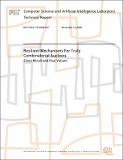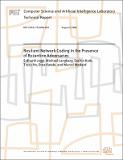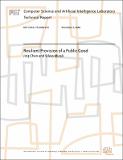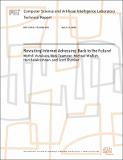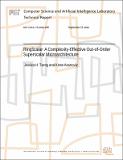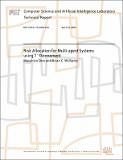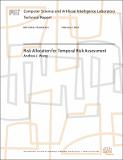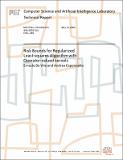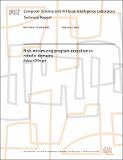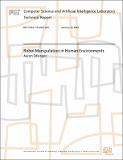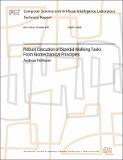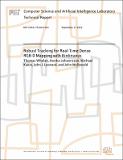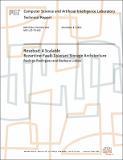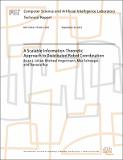Browsing CSAIL Technical Reports (July 1, 2003 - present) by Title
Now showing items 598-617 of 775
-
Resilient Mechanisms For Truly Combinatorial Auctions
(2008-11-13)Dominant-strategy truthfulness is traditionally considered the best possible solution concept in mechanism design, as it enables one to predict with confidence which strategies INDEPENDENT players will actually choose. ... -
Resilient Network Coding In the Presence of Byzantine Adversaries
(2006-08-05)Network coding substantially increases network throughput. But since it involves mixing of information inside the network, a single corrupted packet generated by a malicious node can end up contaminating all the information ... -
Resilient Provision of a Public Good
(2008-12-02)We present two resilient mechanisms for the provision of a public good. Both mechanisms adopt a knowledge-based benchmark. -
Revenue in Truly Combinatorial Auctions and Adversarial Mechanism Design
(2007- 11-0)Little is known about generating revenue in UNRESTRICTED combinatorial auctions. (In particular, the VCG mechanism has no revenue guarantees.) In this paper we determine how much revenue can be guaranteed in such auctions. ... -
Revisiting Internet Adressing: Back to the Future!
(2006-04-14)IP prefixes undermine three goals of Internet routing: accurate reflection of network-layer reachability, secure routing messages, and effective traffic control. This paper presents Atomic IP (AIP), a simple change to ... -
RingScalar: A Complexity-Effective Out-of-Order Superscalar Microarchitecture
(2006-09-18)RingScalar is a complexity-effective microarchitecture for out-of-order superscalar processors, that reduces the area, latency, and power of all major structures in the instruction flow. The design divides an N-way ... -
Risk Allocation for Multi-agent Systems using Tatonnement
(2009-04-22)This paper proposes a new market-based distributed planning algorithm for multi-agent systems under uncertainty, called MIRA (Market-based Iterative Risk Allocation). In large coordination problems, from power grid management ... -
Risk Allocation for Temporal Risk Assessment
(2013-01-31)Temporal uncertainty arises when performing any activity in the natural world. When activities are composed into temporal plans, then, there is a risk of not meeting the plan requirements. Currently, we do not have ... -
Risk Bounds for Mixture Density Estimation
(2004-01-27)In this paper we focus on the problem of estimating a boundeddensity using a finite combination of densities from a givenclass. We consider the Maximum Likelihood Procedure (MLE) and the greedy procedure described by Li ... -
Risk Bounds for Regularized Least-squares Algorithm with Operator-valued kernels
(2005-05-16)We show that recent results in [3] on risk bounds for regularized least-squares on reproducing kernel Hilbert spaces can be straightforwardly extended to the vector-valued regression setting. We first briefly introduce ... -
Risk-minimizing program execution in robotic domains
(2012-02-02)In this thesis, we argue that autonomous robots operating in hostile and uncertain environments can improve robustness by computing and reasoning explicitly about risk. Autonomous robots with a keen sensitivity to risk can ... -
Robot Manipulation in Human Environments
(2007-01-16)Human environments present special challenges for robot manipulation. They are often dynamic, difficult to predict, and beyond the control of a robot engineer. Fortunately, many characteristics of these settings can be ... -
Robust Execution of Bipedal Walking Tasks From Biomechanical Principles
(2006-04-28)Effective use of robots in unstructured environments requires that they have sufficient autonomy and agility to execute task-level commands successfully. A challenging example of such a robot is a bipedal walking machine. ... -
Robust Tracking for Real-Time Dense RGB-D Mapping with Kintinuous
(2012-09-17)This paper describes extensions to the Kintinuous algorithm for spatially extended KinectFusion, incorporating the following additions: (i) the integration of multiple 6DOF camera odometry estimation methods for robust ... -
Robust, Goal-directed Plan Execution with Bounded Risk
(2012-02-02)There is an increasing need for robust optimal plan execution for multi-agent systems in uncertain environments, while guaranteeing an acceptable probability of success. For ex- ample, a fleet of unmanned aerial vehicles ... -
Rosebud: A Scalable Byzantine-Fault-Tolerant Storage Architecture
(2003-12-17)This paper presents Rosebud, a new Byzantine faulttolerantstorage architecture designed to be highly scalableand deployable in the wide-area. To support massiveamounts of data, we need to partition the data among thenodes. ... -
Rotation Invariant Object Recognition from One Training Example
(2004-04-27)Local descriptors are increasingly used for the task of object recognition because of their perceived robustness with respect to occlusions and to global geometrical deformations. Such a descriptor--based on a set of ... -
Safe Open-Nested Transactions Through Ownership
(2008-02-20)Researchers in transactional memory (TM) have proposed open nesting asa methodology for increasing the concurrency of a program. The ideais to ignore certain "low-level" memory operations of anopen-nested transaction when ... -
Scalable directoryless shared memory coherence using execution migration
(2010-11-22)We introduce the concept of deadlock-free migration-based coherent shared memory to the NUCA family of architectures. Migration-based architectures move threads among cores to guarantee sequential semantics in large ... -
A Scalable Information Theoretic Approach to Distributed Robot Coordination
(2011-09-25)This paper presents a scalable information theoretic approach to infer the state of an environment by distributively controlling robots equipped with sensors. The robots iteratively estimate the environment state using a ...

